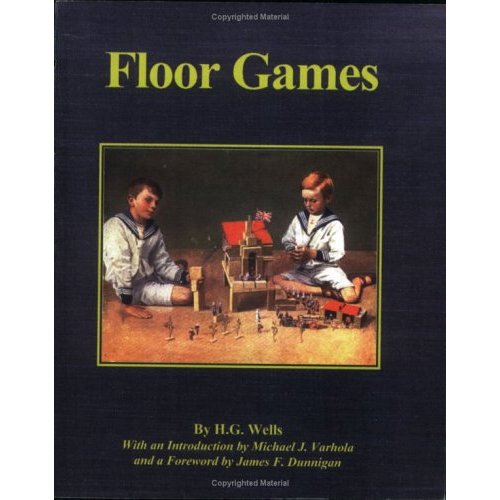Floor Games
Was out at my favorite local game store today, the Game Parlor in Chantilly, Virginia, where I gamed Marsten Moor, a musket and pike battle from the English Civil War (more on that in a separate post).
Despite a thriving scene with throngs of players having at board-, figure-, and role-playing games of all stripes, brick and mortar game stores get by these days by the skin of their teeth; so I always try to spend a little money after spending a part of my day under their roof. Today I restrained myself and rather than a game took home a copy of H. G. Well’s 1911 book Floor Games.

Now Wells is best known in ludology circles for a book he wrote a couple of years later, Little Wars, “for boys from twelve years of age to one hundred and fifty and for that more intelligent sort of girls who like boys’ games and books,” as the text is most obnoxiously subtitled, which introduces simple rules for playing games with toy soldiers. Floor Games is a gentler sort of book, though it’s not above references to “negroid savages” and other charming trappings of Empire.
Here’s how it begins, seeming to anticipate the idea of the magic circle several decades before Huizinga set it down in Homo Ludens:
The jolliest indoor games for boys and girls demand a floor, and the home which has no floor upon which games may be played falls so far short of happiness. It must be a floor covered with linoleum or cork carpet, so that toy soldiers and such-like will stand up upon it, and of a colour and surface that will take and show chalk marks; the common green-coloured cork carpet without a pattern is the best of all. It must be no highway to other rooms, and well it and airy. Occasionally , alas! it must be scrubbed—and then a truce to Floor Games! Upon such a floor may be made an infinitude of imaginative games . . . (3-4)
The chapters that follow sketch out a series of games with titles like “The Game of the Wonderful Islands” (not so wonderful, perhaps, for the aforementioned indigenous populations, consigned by Wells to chasing wild goats around the hills or accosting the encroaching imperialists). Indeed, the unabashed colonialist trappings of those Edwardian spaces are unfortunately reminiscent of the premise of the highly successful modern Euro game Puerto Rico (Rio Grande), in which players are cast in roles that essentially amount to slave traders (excuse me, “plantation owners”). What all of the scenarios have in common though is an emphasis on improvisational play, emergent narrative, and building physical play spaces out of common house-hold materials (here, as in Little Wars, Wells exhibits a general disdain for commercial toy manufacturers).
As the introduction also notes, in several places he comes very close to articulating the principles of what we would today recognize as a role-playing game. It’s worth a look, at least for the historically-minded ludologist. More on my pike pushing anon.